Downton Abbey: The sole survivor of a stately home air disaster
- Published
Len Nitti survived the crash, but comrades including Reginald L Hammond (bottom row, right), Robert L Sprout (bottom row, left) and Daniel Minkon (top row, far right) were killed
Highclere Castle is the setting for the blockbuster TV series Downton Abbey, but the English stately home has had its share of real-life drama. During World War Two its grounds were the scene of several plane crashes - including one from which a single airman would miraculously survive.
Disorientated and barely conscious, Technical Sgt Leonard J Nitti was found slumped up against a cedar tree by gamekeepers and other estate staff.
The 21-year-old radio operator had apparently been thrown clear of a US bomber, the wreckage of which was burning fiercely in the distance.
"There was a flash in front of me," the US airman would recall years later. "I felt as if somebody hit me in the back and took my breath away."
He and his six comrades from the United States Army Air Force 326th Bombardment Squadron had already completed 33 missions and were waiting for orders to return home at the time of the crash.
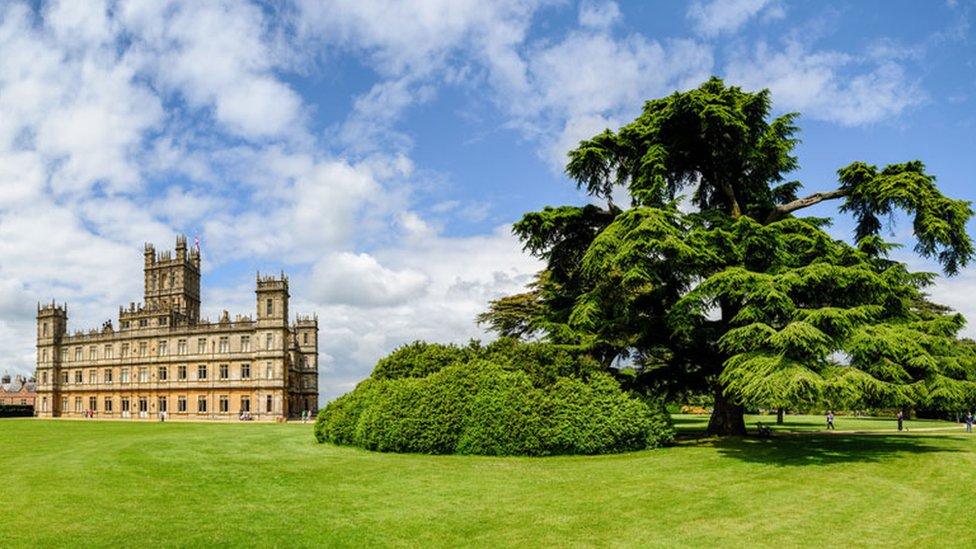
Fragments of the Flying Fortress are still scattered across the grounds of Highclere Castle, which is now a popular tourist attraction
Their B-17 Flying Fortress - named Fort Worth Jailhouse - was on a short non-operational flight to the airbase at nearby Greenham Common and, in bad weather and poor visibility, circled around Highclere Castle before flying off south.
The course proved fatal as the bomber clipped some trees on a large hill and crashed down in the grounds of the stately home.
The other crew members - close friends of T/Sgt Nitti - all died.
The date was 5 May 1945, just three days before the end of World War Two in Europe.
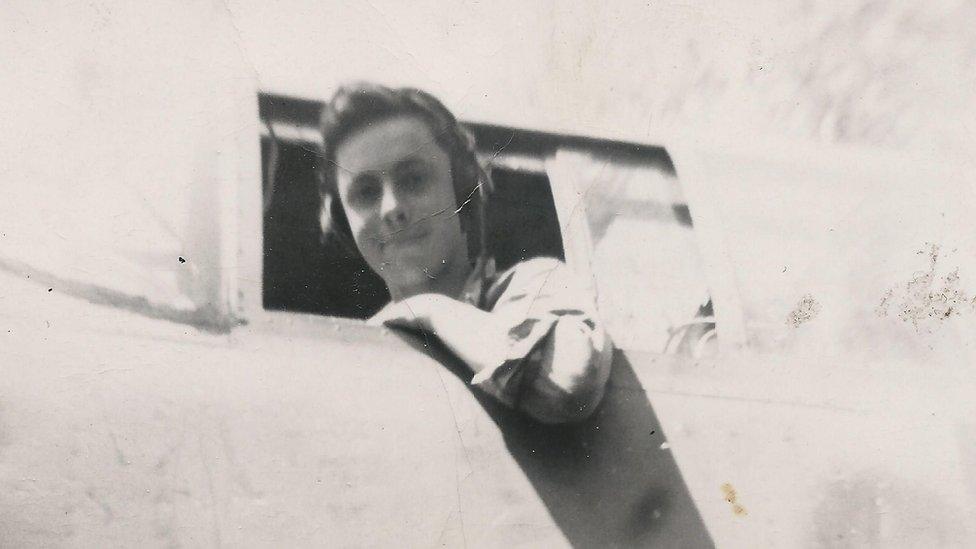
T/Sgt Len Nitti was a radio operator during World War Two
As a war-ravaged continent celebrated VE Day, Len Nitti was recovering from his injuries, which included a broken back and badly burnt hands. Months later, he was transported home to the US to return to civilian life.
He met his wife Joan in 1948, they married four years later and went on to have five children. Mr Nitti became a mechanical engineer and settled with his family in Chicago, where he had been born and raised.
As was common among those who served in World War Two, the former airman rarely spoke of his wartime experiences, nor of the psychological impact of being the only man who took off on that day in May 1945 to survive the experience.
Joan Nitti, who is now 88, said her husband "never talked" about the crash.
"He was a very quiet man, he was a very humble man," she said.
"The only ones that talk about it are the ones that weren't there. But the guys that were really in the thick of it, they would never really talk about it."
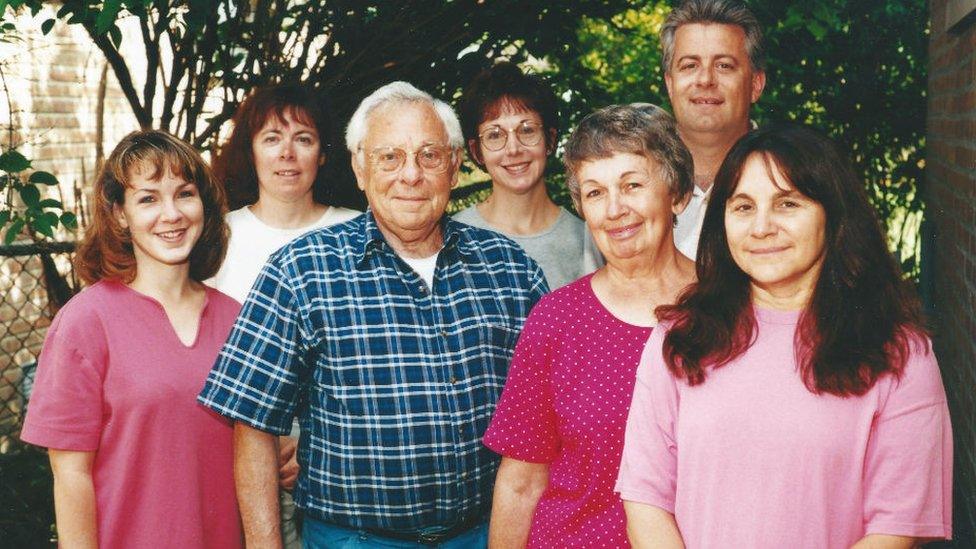
Len and Joan Nitti had five children: (left to right) Laura, Kathy, Patty, Mike and Mary
Years after he had returned home from war, Mrs Nitti recalls attending a military reunion in Texas with her husband.
As the couple entered a tent, a former comrade stood up, "turned white" and said: "My God, Nitti, you're alive! I thought you were dead."
It transpired that some of his fellow airmen had flown over the crash site the following day and assumed the entire crew of the B-17 had been killed.
"They were misinformed," said Mrs Nitti succinctly.
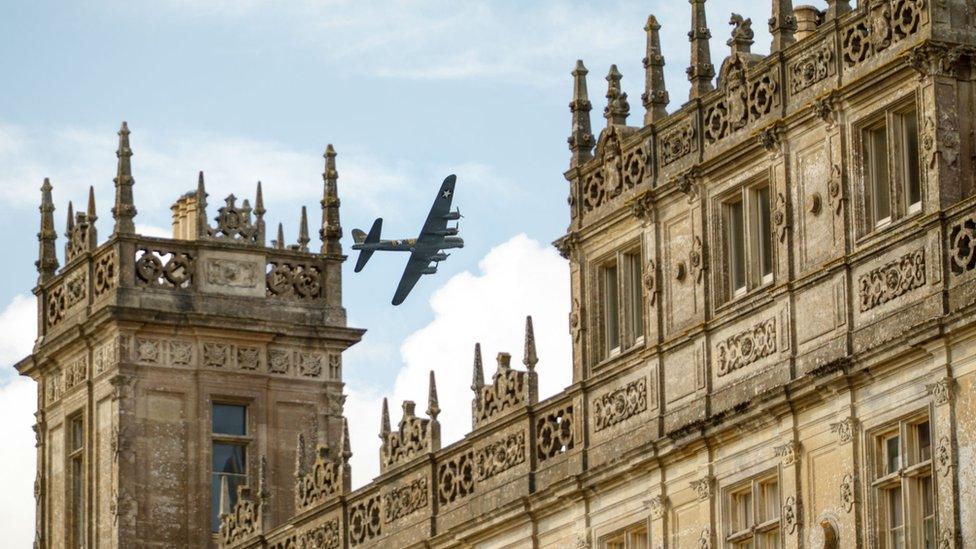
A B-17 flew over the castle at a memorial event this year
Len Nitti might well have assumed he would never return to the UK as he went home to the US late in 1945 - much less to the exact spot where he'd been found so badly injured months earlier.
But in 1990, he came back to Britain - and to Highclere.
Mrs Nitti said the closer she and her family got to England, "the tenser he got in that aeroplane".
It was a trip that caused the memories and emotions of the disaster to resurface, feelings the father of five had largely kept to himself.
"I gave him a lot of credit because on that flight back to England, he had white knuckles," his wife said.
On arrival at the Hampshire stately home, which is about 60 miles south-west of London, Mrs Nitti said an elderly gardener came straight up to her husband "with tears in his eyes".
"He said 'we heard the crash and I was one of the first ones that ran up the hill'.
"I don't know how the heck he ran up the hill because that's a long run, but he said he found Ned (as he was known to his family) slumped up against the tree."
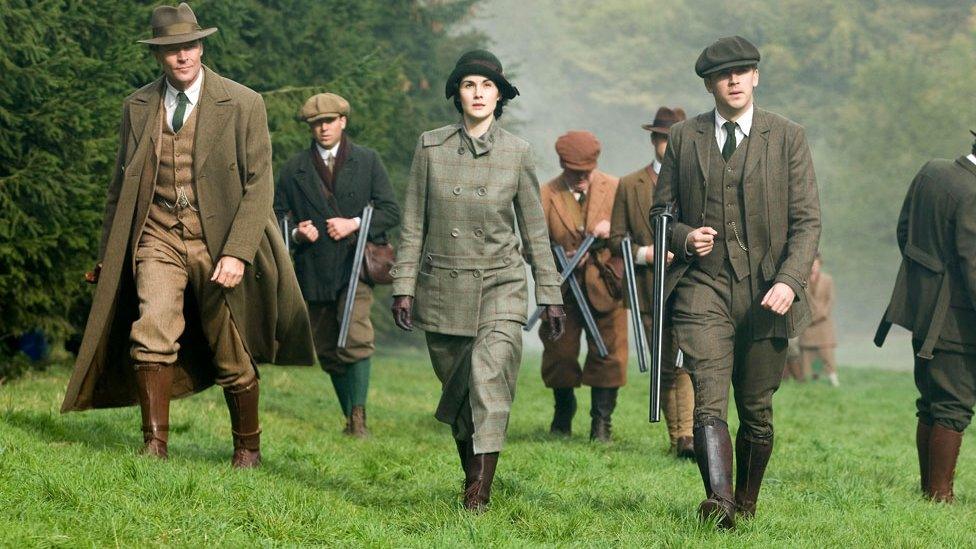
Highclere Castle was the primary setting for all six TV series of Downton Abbey, and is also a key filming location for a movie due to be released next year
As the family retraced the stages of the B-17's crash, Mr Nitti - without any guidance - walked up to the cedar tree where he had been found injured more than four decades earlier.
"The look on his face," said Mrs Nitti.
"I can't imagine what he was thinking about."
Their daughter, Mary Nitti, said: "Dad really needed that closure. He needed to go back and face that demon.
"I think it helped him in a lot of ways."
In a family video shot on the 1990 trip - which captures Mr Nitti recovering a fragment of the stricken B-17 - her father recalled having had a "feeling something was going to happen" moments before the plane struck the trees of Sidown Hill.
"I grabbed my chute. I stood up and there was a flash in front of me," said Mr Nitti, who was in the back of the plane while the rest of the crew sat up front in the cockpit.
"The last I remember is that there was a tree. I think the plane split in half."
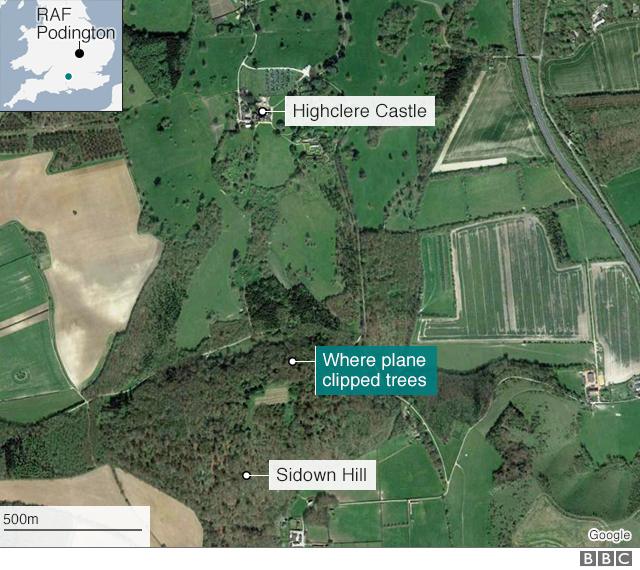
The B-17, which had taken off from RAF Podington, circled over Highclere Castle before it headed off towards Sidown Hill
But how exactly did the young radio operator survive?
"The weather was pretty bad, with low cloud, rain and poor visibility," said historian and former Concorde pilot Stephen Bohill-Smith.
"We think the aircraft overshot Greenham Common by a mile or two. The gamekeepers said they heard the bomber circling over the top of the castle, go round the castle twice and then set off in a southerly direction."
A 266-metre (873ft) hill suddenly appeared before the pilots' eyes.
"They saw it at the last minute, gunned the engines, pulled up, but unfortunately they clipped the top of the trees and the aircraft came down and crashed down on the other side of the hill," said Mr Bohill-Smith.
He said the radio operator was probably thrown from the plane on impact, before the wrecked bomber came down the hill, because he was found quite a distance from the B-17.
The airman was "thrown backwards inside the tail section and he came down and that's what saved his life", said Mr Bohill-Smith.

With a 103ft (31m) wingspan and powered by four engines, the B-17 bomber, nicknamed the Flying Fortress, could carry 6,000lbs (2,700kg) of bombs as far as Berlin
Roger Mills, who is one of the pilots of Europe's last airworthy B-17, external, told the BBC that the sheer size of the bomber and its "very basic" flying controls and instruments would have contributed to the crew being unable to avoid clipping the hilltop trees.
"You need visual sighting to make any manoeuvres and, as the sighting came too late, there was nothing they could do about it," he said.
"Having seen the hill ahead of them, there would have been a lot of adrenaline. There would have been a call for full power and then a lot of muscle to pull the nose up.
"I think they realised it was going to be too late and they were going to hit the hill."
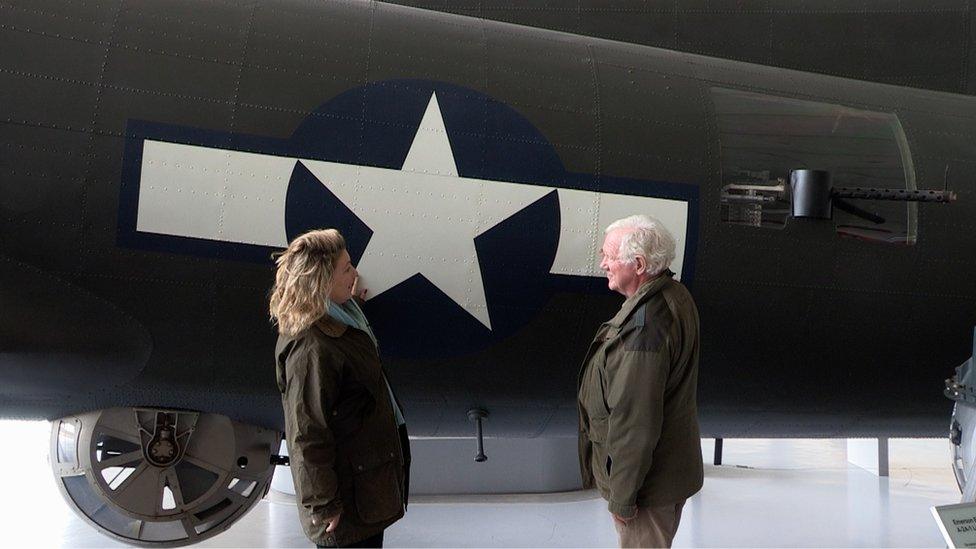
Lady Carnarvon, who lives in Highclere Castle, discusses with Stephen Bowhill-Smith how Len Nitti survived the B-17 crash
Len Nitti died aged 94 on 21 January 2018, days after he learned of plans by the owners of Highclere Castle, the Earl and Countess of Carnarvon, to honour the airmen who lost their lives on the estate.
"He had this silly grin on his face," said Mrs Nitti.
"He was so delighted. Those guys were really close friends.
"He looked at me and he had tears in his eyes - and my husband never cried.
"It meant an awful lot to him and I'm glad he got to hear it."

The cedar statue in memory of 1st Lt Reginald L Hammond, 1st Lt Robert L Sprout, T/Sgt Jacob Buikema, S/Sgt Daniel Minkon, 2nd Lt John F Duffy, and 2nd Lt William J Dutton, who all died in the crash Len Nitti survived
In September, a sculpture of an airman carved out of a cedar tree was unveiled at Highclere Castle to mark the sacrifice of the men who died in the B-17 crash, and the 13 others who were killed in different air accidents in the grounds of Highclere during World War Two.
"My dad didn't talk much and he didn't toot his own horn," Mary Nitti said.
"It really was not until we had the event at Highclere, [we realised] how important it was he survived.
"To know what he represented is quite amazing."
- Published19 September 2018

- Published9 September 2017
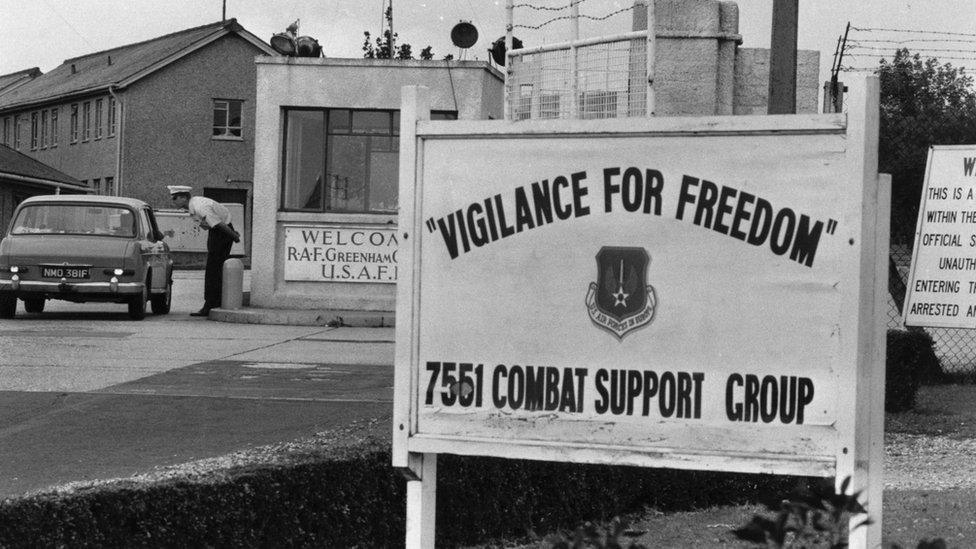
- Published25 June 2015
